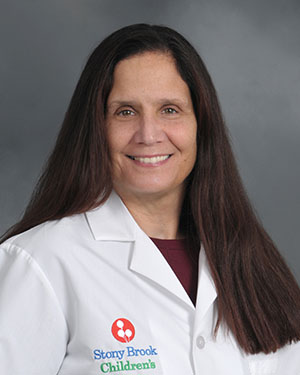Navigation Pediatric Neurosciences Center
Pediatric Neurosurgery
Stony Brook Children's is a major clinical and research center for pediatric neurosurgery and the only pediatric neurosurgery program in Suffolk County on Long Island, with two specially trained, board-certified, pediatric neurosurgeons, Dr. David Chesler and Dr. Michael Egnor.
We offer comprehensive, multidisciplinary services, collaborating closely with our colleagues in pediatric neurology, pediatric intensive care and other subspecialties. In particular, we are committed to using minimally invasive procedures to minimize trauma and complications, and help children get back to their lives sooner. Our patients also have access to all the ancillary services available in an academic medical center, including state-of-the-art diagnostic imaging, Child Life services, and more. Each year, we perform about 200 neurosurgical operations and see about 1,200 children on an outpatient basis.
Our Services
Stony Brook's Pediatric Neurosurgery Division diagnoses and treats a broad range of brain and spine problems. As part of Suffolk County’s only academic medical center, we have access to the most advanced technology and treatments available.
One type of treatment that we frequently use is neuroendoscopy, which allows us to go into the ventricles (interconnected, fluid-filled spaces) of the brain and place catheters (thin tubes), to open cysts using a minimally invasive approach.
We also treat craniosynostosis (a birth defect caused when the joints between the bones of a baby’s skull close prematurely), using minimally invasive endoscopic techniques. For treatment of tumors, we use a sophisticated three-dimensional, computer-generated stereotactic technique that enables us to locate and treat hard to reach tumors that would otherwise be untreatable.
In addition, we serve as the only major pediatric neurosurgical center for trauma on eastern Long Island.
The scope of diagnoses that we treat includes:
- Arnold Chiari Deformity
- Arteriovenous Malformation
- Brain Aneurysm
- Craniosynostosis
- Epilepsy
- Hydrocephalus
- Moyamoya
- Pediatric Brain Tumors
- Pediatric Spine Surgery
- Skull Base Tumors
- Spinal Tumors
- Tethered Spinal Cord
Pediatric Neurosurgery Team
Additional Expertise
Dr. Egnor, Dr. Chesler and the neurosurgical team, including world-renowned cerebrovascular physician, Dr. David Fiorella, work closely to provide care for pediatric patients with brain aneurysms, Moyamoya disease or arteriovenous malformations.
Patients have access to the full complement of other pediatric specialists and subspecialists at Stony Brook Children’s Hospital. These include:
- Neuroradiologists
- Pediatricians
- Pediatric intensivists
- Pediatric oncologists
- Radiation oncologists
- Pediatric nurses
- Child-life specialists
- Social workers
This collaborative approach brings to our children expert, coordinated care that addresses their highly individual needs.
Research and Education
The Division has concentrated significant research effort—both basic science and clinical studies—on understanding and treating hydrocephalus. The working theory is that hydrocephalus is related to the pulsatility (rhythmic beating) of the flow of cerebrospinal fluid to the brain. The goal is to be able to develop better shunts or other devices to treat hydrocephalus. Dr. Egnor and colleagues have published numerous scientific papers describing their efforts and discoveries. Dr. Chesler's area of research interest is the development of new treatments for brain tumors, and also includes the development of new therapies for the treatment of brain cancers.
Advances and Recognitions
Dr. Michael Egnor has been caring for the pediatric neurosurgery patients in Suffolk County since 1987. He was recognized repeatedly for his teaching ability as well as his work with abused and neglected children. His awards include twice receiving the "Outstanding Teaching Abilities in Pediatrics from the Department of Pediatrics." He also has received the Child Abuse and Neglect Volunteer and Professional of the Year Award in Health Brookhaven Youth Bureau.
Dr. David Chesler joined the Neurosurgery Department in 2014 following a Pediatric Neurosurgery Fellowship at Johns Hopkins Medical Center. He is highly trained in use of minimally invasive surgical techniques for the treatment of spine and brain tumors, epilepsy, and the endoscopic correction of Craniosynostosis. He also earned a PhD in neuroimmunology at New York University and is pursuing research in the development of novel therapies for the treatment of pediatric brain tumors.



